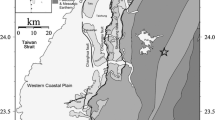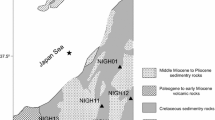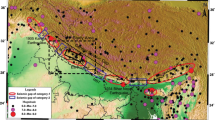Abstract
Modification in the semi-empirical technique for the simulation of strong ground motion has been introduced to incorporate the strong motion generation areas (SMGA) in the modeled rupture plane. Strong motion generation areas identified within the rupture plane of the Tohoku earthquake of March 11, 2011 (M w = 9.0), have been modeled using this modified technique. Two different source models having four and five SMGAs, respectively, are considered for modeling purpose. Strong motion records using modified semi-empirical technique have been simulated at two near-field stations located at epicentral distance of 137 and 140 km, respectively, using two different source models. Comparison of the observed and simulated acceleration waveforms is made in terms of root mean square error (RMSE) at both stations. Minimum root mean square error of the waveform comparison has been obtained at both the stations for source model having five SMGAs. Simulations from same rupture model have been made at other four stations lying at epicentral distance between 154 and 249 km. Comparison of observed and simulated records has been made in terms of RMSE in acceleration records, velocity records and response spectra at each six station. Simulations have been made at six other stations to obtain distribution of peak ground acceleration and peak ground velocity with hypocentral distance. Peak ground acceleration and velocity from simulated and observed records are compared at twelve stations surrounding the source of Tohoku earthquake. Comparison of waveforms and parameters extracted from observed and simulated strong motion records confirms the efficacy of the developed modified technique to model earthquake characterized by SMGAs.













Similar content being viewed by others
References
Asano K, Iwata T (2012) Source model for strong ground motion generation in 0.1–10 Hz during the 2011 Tohoku earthquake. Earth Planet Space 64(12):111–1123. doi:10.5047/eps.2012.05.003
Boore DM (1983) Stochastic simulation of high frequency ground motion based on seismological models of radiated Spectra. Bull Seism Soc Am 73:1865–1894
Boore DM, Atkinson GL (1987) Stochastic prediction of ground motion and spectral response parameters at hard rock sites in Eastern North America. Bull Ind Soc Earthq Tech 29:440–467
Brune JN (1970) Tectonic stress and spectra of seismic shear waves from earthquakes. J Geophys Res 75:4997–5009
Gusman AR, Tanioka Y, Sakai S, Tsushima H (2012) Source model of the great 2011 Tohoku earthquake estimated from tsunami waveforms and crustal deformation data. Earth Planet Sci Lett 341–344:234–242
Hadley DM, Helmberger DV (1980) Simulation of ground motions. Bull Seism Soc Am 70:617–630
Hanks TC, McGuire RK (1981) The character of high frequency ground motion. Bull Seism Soc Am 71:2071–2095
Hartzell SH (1978) Earthquake aftershocks as Green’s functions. Geophys Res Lett 5:1–4
Hartzell SH (1982) Simulation of ground accelerations for May 1980 mammoth lakes, California earthquakes. Bull Seism Soc Am 72:2381–2387
Honda R, Aoi S, Sekiguchi H, Morikawa N, Kunugi T, Fujiwara H (2005) Ground motion and rupture process of the 2004 mid Niigata prefecture earthquake obtained from strong motion data of K-NET and KiK-net. Earth Planet Space 57:527–532
Housner GW, Jennings PC (1964) Generation of artificial earthquakes. Proc ASCE 90:113–150
Hutchings L (1985) Modeling earthquakes with empirical green’s functions (abs). Earthq Note 56:14
Irikura K (1983) Semi-empirical estimation of strong ground motion during large earthquakes. Bull Dis Prev Res Inst 33:63–104
Irikura K (1986) Prediction of strong acceleration motion using empirical green’s function. Proceedings of the 7th Japan earthquake engineering symposium, pp 151–156
Irikura K, Kamae K (1994) Estimation of strong ground motion in broad-frequency band based on a seismic source scaling model and an empirical green’s function technique. Ann Geofis XXXVII(6):1721–1743
Irikura K, Muramatu I (1982) Synthesis of strong ground motions from large earthquakes using observed seismograms of small events. Proceeding of the Third International Microzonation Conference, Seattle, pp. 447–458
Joshi A (2001) Strong motion modelling of the source of the Chamoli earthquake of March 29, 1999 in the Garhwal Himalaya, India. J Seismol 5:499–518
Joshi A (2004) A simplified technique for simulating wide band strong ground motion for two recent Himalaya earthquakes. Pure Appl Geophys 161:1777–1805
Joshi A, Midorikawa S (2004) A simplified method for simulation of strong ground motion using rupture model of the earthquake source. J Seism 8:467–484
Joshi A, Mohan K (2008) Simulation of accelerograms from simplified deterministic approach for the 23rd October 2004 Niigata-ken Chuetsu earthquake. J Seismol 12:35–51
Joshi A, Patel RC (1997) Modelling of active lineaments for predicting a possible earthquake scenario around Dehradun, Garhwal Himalaya, India. Tectonophysics 283:289–310
Joshi A, Kumar B, Sinvhal A, Sinvhal H (1999) Generation of synthetic accelerograms by modelling of rupture plane. J Earthq Tech 36:43–60
Joshi A, Singh S, Giroti K (2001) The simulation of ground motions using envelope summations. Pure Appl Geophys 158:877–901
Joshi A, Kumari Pushpa, Sharma ML, Ghosh AK, Agarwal MK, Ravikiran A (2012a) A strong motion model of the 2004 great Sumatra earthquake: simulation using a modified semi-empirical method. J Earthq Tsunami 6:1–29
Joshi A, Kumari Pushpa, Singh S, Sharma ML (2012b) Near-field and far-field simulation of accelerograms of Sikkim earthquake of September 18, 2011 using modified semi-empirical approach. Nat Hazard 64:1029–1054
Kamae K, Irikura K (1992) Prediction of site specific strong ground motion using semi-empirical methods. Proceedings of the 10th World Conference on Earthquake Engineering, pp 801–806
Kamae K, Kawabe H (2004) Source model composed of asperities for the 2003 Tokachi-oki, Japan, earthquake (MJMA = 8.0) estimated by the empirical Green’s function method. Earth Planet Space 56:323–327
Kameda H, Sugito M (1978) Prediction of strong earthquake motions by evolutionary process model. In: Proceedings of the sixth Japan earthquake engineering symposium, pp 41–48
Kanamori H (1979) A semi-empirical approach to prediction of long period ground motions from great earthquakes. Bull Seism Soc Am 69:1645–1670
Kanamori H, Anderson DL (1975) Theoretical basis of some empirical relations in seismology. Bull Seism Soc Am 65:1073–1095
Koketsu K, Miyake H, Fujiwara H, Hashimoto T (2008) Progress towards a Japan integrated velocity structure model and long-period ground motion hazard map, Proceeding of 14th World Conference. Earthq Eng pp. S10–038
Koketsu K, Yokota Y, Nishimura N, Yagi Y, Miyazaki S, Satake K, Fujii Y, Miyake H, Sakai S, Yamanaka Y, Okada T (2011) A unified source model for the 2011 Tohoku earthquake. Earth Planet Sci Lett 310:480–487
Kumar D, Khattri KN (1999) Average Intrinsic Qs in the crust and uppermost 8 km of Mantle in the Ganga Plains, Bihar. Curr Sci 77:748–749
Kurahashi S, Irikura K (2011) Source model for generating strong ground motions during the 2011 off the Pacific coast of Tohoku Earthquake. Earth Planet Space 63:571–576
Lai SP (1982) Statistical characterization of strong ground motions using power spectral density function. Bull Seism Soc Am 72:259–274
Lay T, Wallace TC (1995) Modern global seismology Academic Press, California, p 521
Midorikawa S (1989) Synthesis of ground acceleration of large earthquakes using acceleration envelope waveform of small earthquake. J Struct Construct Eng 398:23–30
Midorikawa S (1993) Semi-empirical estimation of peak ground acceleration from large earthquakes. Tectonophysics 218:287–295
Mikumo T, Irikura K, Imagawa K (1981) Near field strong motion synthesis from foreshock to aftershock records and rupture process of the main shock fault (abs.). IASPEI 21st General Assembly, London
Miyahara M, Sasatani T (2004) Estimation of source process of the 1994 Sanriku Haruka-oki earthquake using empirical Green’s function method. Geophys Bull Hokkaido Univ Sapporo Japan 67:197–212 (in Japanese with English abstract)
Miyake H, Iwata T, Irikura K (2003) Source characterization for broadband ground-motion simulation: kinematic heterogeneous source model and strong motion generation area. Bull Seism Soc Am 93:2531–2545
Munguia L, Brune JM (1984) Simulations of strong ground motions for earthquakes in the Mexicali-Imperial Valley. Proceeding of workshop on strong ground motion simulation and earthquake engineering applications, Pub. 85–02. Earthquake Engineering Research Institute, Los Altos, California 21-1-21-19
National institute of earth sciences and disaster prevention (2011). 2011 off the Pacific Coast of Tohoku earthquake, strong ground motion, http://www.k-net.bosai.go.jp/k-net/topics/TohokuTaiheiyo_20110311/nied_kyoshin2e.pdf, March 13
Ozawa S, Nishimura T, Munekane H, Suito H, Kobayashi T, Tobita M, Imakiire T (2012) Preceding, coseismic, and post seismic slips of the 2011 Tohoku earthquake, Japan. J Geophys Res Solid Earth 117, Issue B7, doi: 10.1029/2011JB009120
Saikia CK (1993) Ground motion studies in great Los Angles due to M w = 7.0 earthquake on the Elysian thrust fault. Bull Seism Soc Am 83:780–810
Saikia CK, Herrmann RB (1985) Application of waveform modelling to determine focal mechanisms of four 1982 Miramichi aftershocks. Bull Seism Soc Am 75:1021–1040
Santisi d’Avila MP, Semblat JF, Lenti L (2013) Strong ground motion in the 2011 Tohoku Earthquake: a one directional three-component modeling. Bull Seism Soc Am Special Issue on 2011 Tohoku Earthquake, 103 (2b): 1394–1410
Satoh T, Kawase H, Sato T (1997) Statistical spectral model of earthquakes in the eastern Tohoku district, Japan, based on the surface and borehole records observed in Sendai. Bull Seism Soc Am 87:446–462
Suzuki W, Iwata T (2007) Source model of the 2005 Miyagi-Oki, Japan, earthquake estimated from broadband strong motions. Earth Planet Space 59:1155–1171
Takiguchi M, Asano K, Iwata T (2011) The comparison of source models of repeating subduction-zone earthquakes estimated using broadband strong motion records–1982 and 2008 Ibaraki-ken-oki M7 earthquakes. J Seism Soc Jpn 63:223–242 (in Japanese with English abstract)
Wu C, Koketsu K, Miyake H (2008) Source processes of the 1978 and 2005 Miyagi-oki, Japan, earthquakes: repeated rupture of asperities over successive large earthquakes. J Geophys Res 113:B08316
Irikura K, Kagawa T, Sekiguchi H (1997) Revision of the empirical green’s function method by Irikura, 1986 programme and abstracts. Seismol Soc Jpn 2:B25
Yu G (1994) Some aspects of earthquake seismology slip portioning along major convergent plate boundaries: composite source model for estimation of strong motion and non linear soil response modeling. University of Nevada, Thesis
Yu G, Khattri KN, Anderson JG, Brune JN, Zeng Y (1995) Strong ground motion from the Uttarkashi, Himalaya, India and earthquake: comparison of observations with synthetics using the composite source model. Bull Seism Soc Am 85:31–50
Zeng Y, Anderson JG, Su F (1994) A composite source model for computing realistic synthetic strong ground motions. Geophys Res Lett 21:725–728
Acknowledgments
We used the waveform data provided by the KiK-net of the National Research Institute for Earth Science and Disaster Prevention (NIED), Japan. The data obtained from http://www.k-net.bosai.go.jp/k-net/ are thankfully acknowledged. Discussions at various stages with Midorikawa are also acknowledged. The work presented in this paper is an outcome of the sponsored project from Department of Science and Technology (DST), Government of India with project reference no. GITA/DST/TWN/P-52/2013.
Author information
Authors and Affiliations
Corresponding author
Rights and permissions
About this article
Cite this article
Joshi, A., Sandeep & Kamal Modeling of strong motion generation areas of the 2011 Tohoku, Japan earthquake using modified semi-empirical technique. Nat Hazards 71, 587–609 (2014). https://doi.org/10.1007/s11069-013-0922-5
Received:
Accepted:
Published:
Issue Date:
DOI: https://doi.org/10.1007/s11069-013-0922-5




